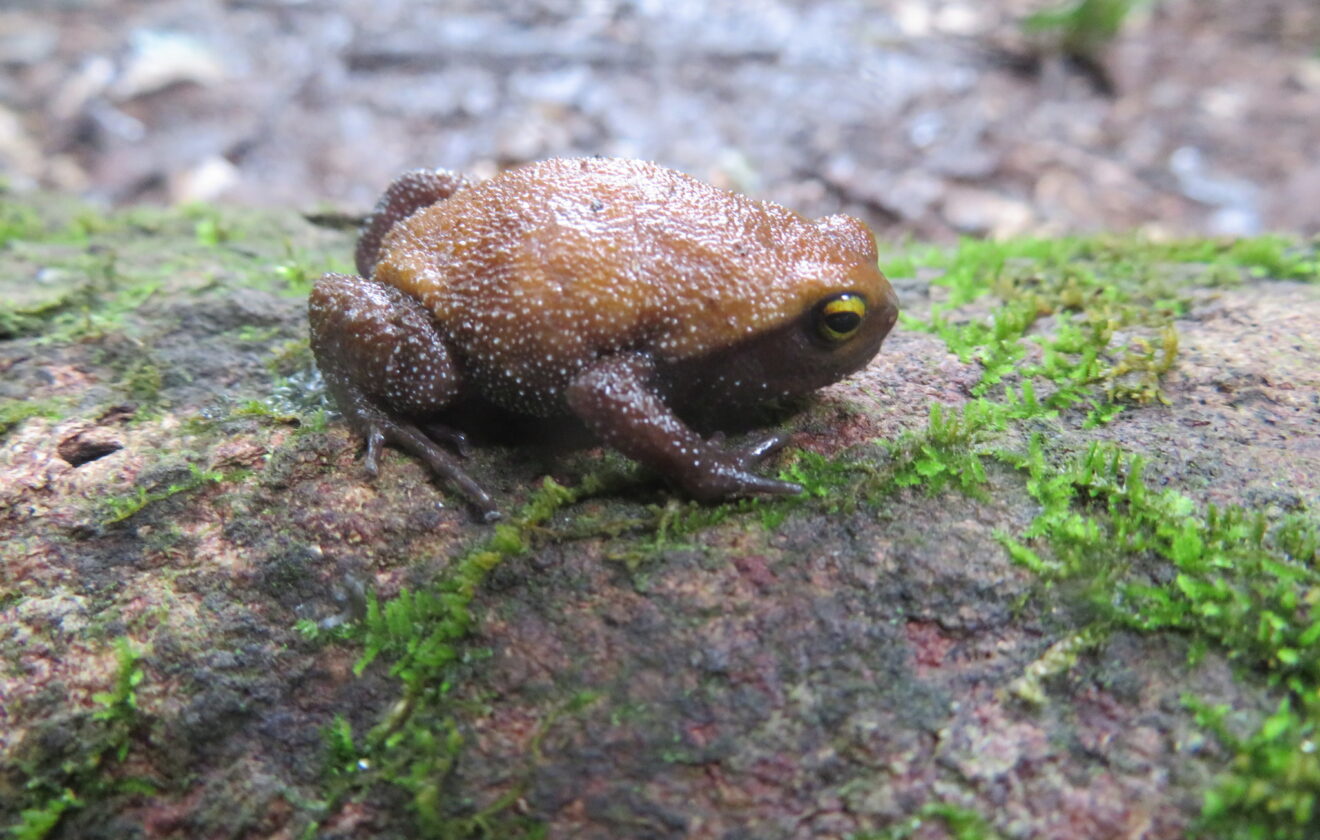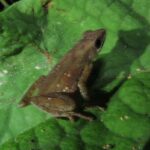- Unveiling the Mysteries of Loveridge's Forest Frog (Probreviceps loveridgei)
- Taxonomy and Classification
- Natural Habitat: A Life Hidden in Leaf Litter
- Physical Characteristics: Master of Camouflage
- Behavior and Life Cycle: Secret Lives of Forest Dwellers
- Ecological Role: Guardians of Ecosystem Stability
- Threats and Conservation Status: Fragility in an Ever-Changing World
- Cultural and Scientific Significance
- Conclusion: The Call for Conservation Action
Unveiling the Mysteries of Loveridge’s Forest Frog (Probreviceps loveridgei)#
Shrouded in the lush, verdant foliage of Tanzania’s Eastern Arc Mountains dwells an elusive and fascinating amphibian, the Loveridge’s forest frog (Probreviceps loveridgei). This diminutive yet enigmatic species captures the imagination from the very first encounter, perfectly adapted for a secretive life hidden beneath layers of moss, leaf litter, and rainforest detritus. Named after esteemed British herpetologist Arthur Loveridge, whose contributions illuminated amphibian diversity in East Africa, this uniquely adapted frog embodies extraordinary evolutionary craftsmanship—a tiny jewel often unnoticed yet remarkably essential to its ecosystem.
Unlike more celebrated tropical frogs that flaunt vibrant colors and elaborate calls, Loveridge’s forest frog quietly exemplifies evolutionary subtlety, camouflaged seamlessly among mossy rocks and decayed wood. Rarely seen by casual observers, its presence signals a healthy, intact rainforest—a crucial indicator species whose very survival carries implications far beyond its small stature.
Taxonomy and Classification#
Probreviceps loveridgei belongs to the family Brevicipitidae, an intriguing family of burrowing frogs known commonly as rain frogs or forest frogs. The genus Probreviceps is specifically adapted to moist, forested habitats and comprises several enigmatic species endemic to isolated montane forests. Classified as follows:
- Kingdom: Animalia
- Phylum: Chordata
- Class: Amphibia
- Order: Anura
- Family: Brevicipitidae
- Genus: Probreviceps
- Species: Probreviceps loveridgei
Closely related species in the genus share similar ecological niches, yet each reveals subtle variations shaped by their unique histories and environmental pressures.
Natural Habitat: A Life Hidden in Leaf Litter#
To truly appreciate Probreviceps loveridgei, one must first journey into the heart of Tanzania’s biologically rich Eastern Arc Mountains. Here, flourishing montane forests cloak peaks and valleys in an emerald embrace, constantly bathed in misty rains and humid conditions—ideal for moisture-loving amphibians. Among the leaf layers carpeting the forest floor, hidden beneath billowing ferns and tangled vines, lives the elusive Loveridge’s forest frog.
This species thrives in habitats characterized by abundant moisture, shade, and organic matter. While other frogs utilize streams, ponds, or tree canopies, Probreviceps loveridgei has evolved specifically for life amid the decaying organic material that carpets the forest floor. The dense shade maintains consistent humidity, crucial for their permeable skin and delicate biological processes.
The leaf litter provides shelter from predators and environments for prey—tiny invertebrates hidden beneath leaf fragments. The frog masterfully navigates through these subterranean layers, their ecology intimately interwoven with the forest cycles of decay and renewal, testament to symbiotic environmental relationships millions of years in the making.
Physical Characteristics: Master of Camouflage#
With a body length rarely exceeding three centimeters, Loveridge’s forest frog exemplifies the wonders of miniaturization. It sports a robust, rounded body adapted explicitly to burrowing and navigating tight spaces among roots, leaf matter, and forest soil. Its limbs, short and muscular, lend exceptional digging capabilities, allowing the frog to quickly bury itself beneath surface vegetation to evade predators and maintain optimal moisture levels.
Coloration in Probreviceps loveridgei is an artistic mastery of natural camouflage, blending earthy shades of brown, greenish-gray, and subtle hints of moss-like green. Finely detailed patterns of patches, spots, and markings allow it to seamlessly merge with surroundings—moss-covered bark, damp leaf litter, or decaying logs. Their skin texture, slightly rough yet delicate, mimics the composition of their natural habitat, perfecting their disguise from the keen eyes of predators.
Large, soulful black eyes protrude slightly from their rounded faces, enhancing visual sensitivity in dim, shaded conditions. These specialized adaptations are not just aesthetic marvels; they’re consequential evolutionary tools, enabling the survival and reproductive success of this secretive amphibian.
Behavior and Life Cycle: Secret Lives of Forest Dwellers#
Life beneath forest canopies follows rhythms dictated by rainfall, temperature, and forest productivity. Loveridge’s forest frog is predominantly nocturnal, emerging from hiding places in humid, cloud-filled twilight hours to forage voraciously on tiny insects, mites, springtails, and other forest-floor arthropods. Using their keen vision and sensitive touch, they gently navigate darkness, ambush unsuspecting prey, and retreat swiftly to safety at any hint of danger.
Mating Rituals and Reproduction#
The breeding habits of Probreviceps loveridgei delight naturalists searching for profound glimpses into amphibian evolution. During breeding seasons aligned to rainy periods, males venture to carefully chosen territories, emitting a quiet, pulsed call that resonates gently through the damp leaf litter—a faint romantic whisper easily missed by those unfamiliar with its delicate rhythm.
Females select mates based upon the subtlety and consistency of these calling patterns, approaching cautiously. Courtship culminates in hidden egg-laying events beneath moist undercover, typically in secluded locations safe from flooding or drying out. Remarkably, this species does not rely on bodies of water for development. Instead, eggs hatch directly into miniature froglets, bypassing the free-swimming tadpole stage, a remarkable reproductive adaptation that further reduces vulnerability and increases survival chances in their forested microhabitats.
Ecological Role: Guardians of Ecosystem Stability#
Loveridge’s forest frog is an integral component of the forest ecosystem’s delicate balance, simultaneously serving as predator and prey amid intricate food webs. As voracious consumers of insect larvae and miniature arthropods harmful to plants, these frogs significantly mitigate pest populations, indirectly supporting plant community health and integrity.
Concurrently, they represent an essential food source for various predators, including snakes, birds, and larger amphibians. Thus, their presence—or absence—affects diverse ecosystem layers, highlighting their invaluable roles as ecological indicators reflecting forest health and integrity.
Threats and Conservation Status: Fragility in an Ever-Changing World#
Probreviceps loveridgei is currently classified by the International Union for Conservation of Nature (IUCN) as “Endangered.” Habitat fragmentation, extensive deforestation driven by unsustainable agriculture, logging, and infrastructure development pose substantial threats. Climate-induced changes such as decreased rainfall, fluctuating temperature patterns, and humidity loss further compromise the frogs’ critical moisture-dependent habitats.
Conservation efforts increasingly prioritize habitat conservation and community-driven programs highlighting the forest’s value beyond short-term gains. Protecting these frogs involves safeguarding entire ecosystems—an approach benefiting countless other species sharing these lush forests.
Cultural and Scientific Significance#
While relatively obscure in global consciousness, Loveridge’s forest frog exemplifies biological significance to scientists studying evolutionary adaptation, reproductive strategies in amphibians, and the impacts of climate change. The species inspires ecological storytelling to local communities, linking traditional wisdom with contemporary conservation messages promoting stewardship of environmental heritage.
The Eastern Arc Mountains, home to this remarkable amphibian, historically and culturally resonate with Tanzanian societies, revered as places of spiritual and ecological significance. Highlighting creatures like Probreviceps loveridgei fosters appreciation of these forests as sanctuaries deserving respect, wonder, and continued protection.
Conclusion: The Call for Conservation Action#
In our ecological quests and through exploration, tiny amphibians like Probreviceps loveridgei invite us to consider the overlooked—the nuances of nature, resilience amid fragility, and interconnectedness of all life. Conservation action directed toward protecting their habitats helps ensure these gentle forest denizens continue their secretive, crucial roles.
As nature enthusiasts, students, and advocates, we share responsibility to learn about, value, and protect such hidden wonders. Engage with conservation initiatives, support reforestation, habitat protection efforts, and spread awareness of extraordinary species like Loveridge’s forest frog—together, let’s safeguard their place in Earth’s rich tapestry of biodiversity.








